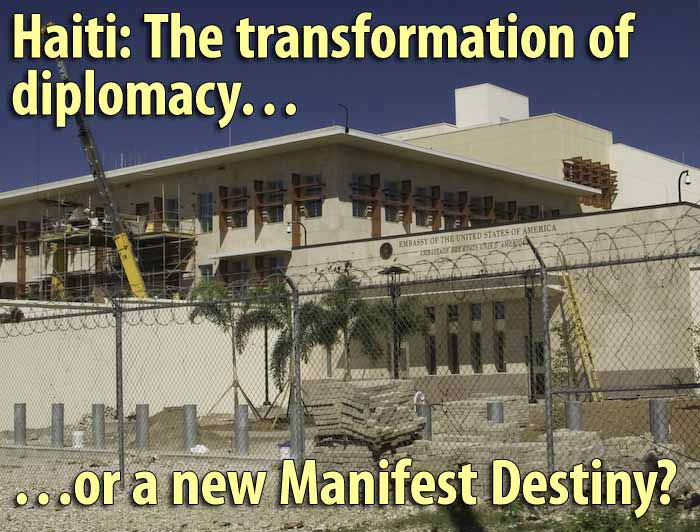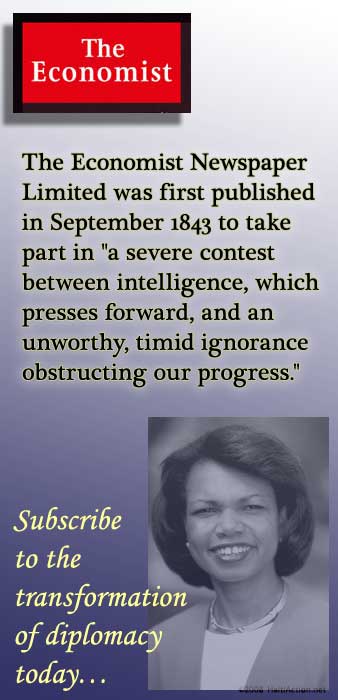|
Haiti: The transformation of diplomacy
or a new Manifest Destiny?
February 28, 2008 |
News
HaitiAction.net |
||||
 |
Haiti: The transformation of diplomacy or a new Manifest Destiny?
Did the desire for a new "US Embassy Compound" in Haiti provide the motive behind the Coup d'État of February 29, 2004?
by Randall White
HaitiAction.net - Port au Prince, Haiti — The US State Department has been unusually productive of late in implementing the reconstruction of most of its foreign mission buildings under a "New Initiatives Division" of the Overseas Buildings Operations Bureau (OBO). It’s certainly understandable, given the realities of the Post 9/11 era, that the Department should rethink its ability to secure the safety of the diplomatic corp and maintain consular services for US citizens abroad. What has now provoked controversy, however, is the scale of some of the "New Embassy Compounds" (NEC). Most notable, for us, is the imperious NEC-Port au Prince, Haiti.
 |
How large does an embassy that, ostensibly, exists to maintain diplomatic relations with a foreign power need to be? And, in particular, why does the U.S. need such a behemoth emblem of its interest in such a small, beleaguered and impoverished nation as Haiti?
The 1998 U.S. Embassy bombings of Nairobi, Kenya and Dar es Salaam, Tanzania, pre-staged the new era. Just last week, Belgrade once again showed that when the US actions provoke local populations the highest profile symbol of the United States government (USG) — the Embassy — becomes an easy target in the center of the capital. It is understandable that when you have a government in power that wishes to maintain a public profile that insists it doesn't need to negotiate US foreign policy or sit down to listen to its opponents, then turning the foreign mission into a fortress is imperative.
To put this in perspective, out of the forty projects worldwide that the New Initiatives Division is completing this year, NEC-Port au Prince is the fourth largest in cost. That might not put a blip on your radar as you watch the Oscars, but let's take a closer look at the simple details of "the top 4 out of 40."
It's no surprise that, coming in at number one, the most expensive new embassy compound would be NEC-Bagdad.
Since the bold agenda of the New America is to wage a perpetual war in the Middle East (some may wish to differ with that analysis), dumping the most tax dollars securing the in-securable NEC-Bagdad in IRAQ is pretty much a no-brainer.
The number two position goes to the largest English-speaking country in the world — China. It makes perfect sense that the USG would put an ambitious project in Beijing. Pretending that you're going to be the power in Beijing that will look after our ultimate security requires a big expensive embassy, in order to maintain what is exactly that — a pretense. Oh, and by the way…
(Speaking of embassies in Belgrade, does anyone remember who bombed the Chinese Embassy on May 7, 1999? Over a billion Chinese do…)
Number three spot goes to Berlin. Given that it maintains the fifth largest GDP at $2.585 trillion (US) — and that Germany is ten times as large as Haiti — it's not hard to see why NEC Berlin is the third largest project.
So, Haiti will get the number four position, when the USG actually moves the Embassy outside of Port au Prince to the Tabarre suburb.
The current USG Embassy is walking distance — eight blocks — from the National Palace. Very convenient for "diplomacy." The new embassy will be eight miles away through the best (or worse, depending on your opinion) traffic that the world can offer.
So, if that still doesn't pull you away from your TV, then consider this:
The next in line at #5 is NEC Mumbai. This metropolis of India's largest city has twice the population of the entire country of Haiti.
Again, what is the backstory here? Could it be that this fourth-largest "transformation of diplomacy" endeavor — as Condoleezza Rice prefers to call the US expansion project — also provided the cadre who decided that Haiti needed it with the motive for sending in the US Marines to kidnap the democratically-elected President of Haiti, Jean Bertrand Aristide? (Whose family home is, interestingly enough, within walking distance of NEC Port au Prince.)
It's as if you were walking your dog around the block and came upon your neighbor driving a few stakes in his front yard. You ask your friendly neighbor what he's planning. "I'm putting in a new sprinkler system. You know, Think Green, and all that. Hehe…" A comment leads to a little chit-chat and you're on your way before your pup decides to do something un-neighborly on that front lawn. Next week when you're walking the dog and are curious about how your neighbor's little "home improvement" project is going, you're looking at three semi-trucks piled high with 12-inch diameter pipe, each pipe around 20 feet long. The first thing you have to say is, "…what's really going on?"
If it "security" you're really concerned with in foreign territory, one thing that is certain is that scaling back on non-essential services and moving as many of the redundant programs back to home base as possible, will insure that the critical services that have to remain are easier to sustain. With today's information age and the fact that the overwhelming product that the US Embassy generates is printed text, then the task at hand isn't "on the horizon" it is sitting right on your desk. Today a one terabyte (1T) disk can be had — from certain street vendors in Port au Prince, even — for less than $500 US. the average 1T hard disk will hold about 220 million pages of text. It's unlikely that the US Embassy in Port au Prince has generated that much paper since 1804, let alone every year.
We're not suggesting — not even for a minute — that the
honorable Ambassador Janet Sanderson and her cohorts can
be replaced by a 6x6x4 inch piece of hardware.
What should come to mind are questions of scale:
- "What is really 'needed' in Haiti?"
- "What is it, really?
Click image for larger view |
 |
 |
18°33'50.84"N 72°14'58.18"W |
- Our facilities play a critical role in Secretary Rice’s focus on transformational diplomacy
- Delicately put in place new and improved diplomatic platforms overseas that provide security and safety, and allow for the transformation of diplomacy for the United States Government"
-OBO publication
In the aftermath of the Coup d'État of February 29, 2004 Secretary of State, Condoleezza Rice saw, yet another, "wonderful opportunity." With a US installed coup government of Gérard Latortue, and the UN occupation forces silencing any resistance, she could introduce a new vision. It was time to sell the diplomatic corp on her "transformational diplomacy." It was neo-conservative rehash of Manifest Destiny. In the post 9/11 era, US foreign policy was going to simply forge ahead and disregard the distractions of the timid. It was — more accurately — going to be a "diplomatic surge."
"A hundred years ago the Americans enlarged the concept of the Monroe Doctrine with the doctrine of Manifest Destiny. It was, they declared, the manifest destiny of the United States not simply to resist Old World aggression but to make the New World into an American protectorate. They proceeded to do just that, tearing Panama from
Colombia to build the Canal, invading or sponsoring insurrections in Honduras, Guatemala, Costa Rica, Nicaragua, El Salvador, the Dominican Republic , Haiti, Cuba and Puerto Rico. Cuba was a de facto colony of the US until the abolition of the Platt Amendment (to the Cuban Constitution) in 1934. Puerto Rico is still a colony. Those states which were not colonies were banana republics – owned and controlled by the American fruit and sugar companies.
"President Eisenhower in 1960 reaffirmed the Monroe Doctrine because of “Cuban hostility” towards the United States. This was because when the US decided to punish Cuba by denying her access to the American sugar market, Cuba promptly sold her sugar to the Soviet Union." -John Maxwell "When Worlds Collide" (June 1997)
Of course, there are strategies other than Rice's "tranformational diplomacy" that could be less provacative. Last week presidential hopeful, Barack Obama, shocked proponents of American Exceptionalism in restating that he would sit down with the elected leaders of Cuba for dialogue.
Sen. Barack Obama: “The problem is if we think that meeting with the president is a privilege that has to be earned, I think that reinforces the sense that we stand above the rest of the world at this point in time, and I think that it’s important for us, in undoing the damage that has been done over the last seven years, for the president to be willing to take that extra step. That’s the kind of step that I would like to take as president of the United States.”
 |
As pointed out before, NEC Port au Prince is actually in Tabarre and further from the purported "seat of power" in Haiti. However it is, much closer to the runway of the Toussaint Louverture International Airport (PAP) than before. Making it easier for those special renditions… I mean, those "special situations" demanded by this new "tranformation of diplomacy." Any demonstrators daring to make the trek out to the remote location will be faced by a new special feature of NEC Port au Prince, seven sparkling new gun-ports — to welcome them — along the top of the main building. This main building — amazingly close to the highway (for security-minded folk) — is ten times as large as the current Embassy downtown. (Plenty of room for that $500 1T drive that they'll need for all the diplomatic work.)
So, there it is. This information should be enough to get you started on your own quest to find out what your government is up to in your name. This is the leap year, and finally, Haiti gets to commemorate their stolen history on a February 29th. There's a lot more to this story, but we're leaving some of that for Part 2. If you want to see that second part appear soon, drop us a message at info@haitiaction.org and send some of your thoughts.
©2008 Randall White - HaitiAction.net
Share this story with your networks
SEE ALSO
Brazilian military’s experience comes full circle in Haiti Feb 20
Haiti's wealthy prosper while the poor decline
Pentagon's troubling role in Haiti Jan 12
Human rights defender forced into hiding in Haiti Dec 27
One Lavalas official freed in Haiti, second remains missing